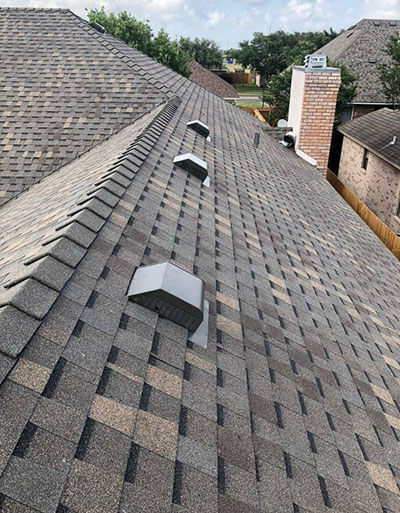A roof can go without shingles for two weeks. And, It would be unwise to leave the roof without shingles or the underlying parts exposed for more than one week, If I’m being honest, as it can eventually cause leaks or other issues that will cause you more problems than they should.
I have a friend whose roof shingles were blown away in a storm, and he left it for quite some time, which caused water leaks and more issues that cost him a lot to fix. So, to answer your question, a roof can go without shingles for not more than one week if the underlying parts are exposed; if not, you can give it a couple of weeks and not more than that.
I will discuss this topic in detail in the following sections. Let’s get into it!
Quick Jump
Will My Roof Leak Without Shingles?

Yes, a roof without shingles is likely to leak because the shingles are essential in keeping water out of the roof. Whether you live in a rainy, snowy, or desert area, and your house has shingles, they act as a barrier against rain, snow, and other precipitation, preventing water from seeping into the underlying layers of the roof.
Without shingles, water can easily penetrate the roof and cause damage to the underlying structure, insulation, and other components of the roof. Not to mention, If the roof decking is exposed to sunlight, it can cause the wood to dry out and shrink, leading to potential leaks and other issues.
But that’s not all! There are other signs and reasons you might need to repair the roof shingles. Those reasons could be;
- The unmistakable sign is that if your roof is missing a few pieces, they might be blown away in the storm.
- Sometimes, you might notice crack or any type of curling on those.
- If the granules are poor quality, they will wash away if no shingles or granules are exposed. In that case, you might need to repair it.
- And this issue you will notice this immediately after you look at the roof, which is the shingles are not even, and they are somewhat not flat enough. It’s because those have sagged, and you must change them too.
- Lastly, you might find algae on the roof which will eventually damage the shingles and leave your roof exposed to further damage and leaking.
These are more or less some signs and issues you might face or notice, and when these happen, you need to remove and repair the shingles as soon as possible because you don’t want to cause these any further hassle.
How to Repair or Remove the Damaged Shingles on Your Roof (DIY)

Without further ado, let’s start repairing those shingles. But, before you do that, you will need a few tools to get it sorted.
You probably have these tools in your garage, but here is a checklist.
- New shingles (If necessary, and better to have great ones).
- Cement (Get ones that are primarily for the roofing)
- Hammer and nails (Four nails per new shingles at least)
- A crowbar or pry-bar.
- And glue.
Now, if you have these, you can start. It will take five steps, and then you’re done.
Step #1: You need to start inspecting the shingles to determine the extent of the damage. If the damage is not that vast and minor, you can repair the shingle without replacing it if you think it needs to be repaired. However, in some cases, the shingle must be replaced if it is severely damaged or missing.
Step #2: The process is the same for all if you need to repair or remove multiple shingles. You need to get your pry bar first. Then, remove any roofing nails and gently lift the damaged shingle. Many use glue bonds, so you must take care of that too.
Step #3: Similarly, replace that place with new shingles and put the nails on it. After that, apply roofing cement to the nail heads to ensure a watertight seal. Don’t forget to use glue to give the edges a better grip.
Step #4: When you’re done with that, get the cement again, and apply it around the edges of the replacement shingle and the surrounding shingles to create a tight seal and prevent water from penetrating the roof. It will give it better protection.
Step #5: In this step, you just have to ensure that the replacements are secure and watertight.
That’s all you need to do! The process isn’t complicated, and you will have your shingles fixed in no time!
How Do I Protect My Roof Shingles?
Nobody wants to go through all these hassles, and I’m sure you don’t either. There are ways that you can prevent this from happening again and protect your roof shingles.
As you might already know, there are different types of roof shingles depending on the material used. In that case, you need to take other prevention measurements for that. I’ll go through them all one by one.
But, before that, some rules of thumb go for all kinds of shingles, no matter the material.
Tactic #1: The first prevention tactic is regularly removing debris such as leaves, branches, and other debris to help prevent moisture buildup and protect your shingles from damage.
Tactic #2: Another issue that always happens with me, and many others, is overhanging tree branches can scratch the shingles and damage them. In that case, ensure that to keep them trimmed back.
Tactic #3: Sometimes, our roof suffers because of improper attic ventilation. But without a standard ventilation system in the attic, it can’t help regulate the temperature and moisture levels in the roof, which can help prevent damage to the shingles.
Tactic #4: Lastly, use a high-quality underlayment to take a prevention strategy or protect the shingles adequately. Even when there are damaged or blown-away shingles, it will provide an extra layer of protection for the shingles, helping to prevent leaks and other damage. In that case, you can leave the roof without shingles for one month. But of course, you will need to repair that eventually.
Besides, regular roof inspections can help you identify potential problems early on, such as damaged or missing shingles. And always remember to avoid walking on the roof, especially directly on the shingles.
Wrap Up
I hope you have a good idea of what you need to do. Remember not to leave the roof without shingles for longer than two weeks. There are clear signs when you need to repair or replace them.
Besides, if you need to repair them, now you have a guideline on how you will do it. I hope that clears all your confusion, and if you still have any questions regarding this, let me know in the comment section.
I hope you have a great day!

Roger Lewis is an experienced roof repair contractor with over 15 years of industry experience. He is known for his expertise in all aspects of roof repair, including leak detection, shingle replacement, and gutter repair.
